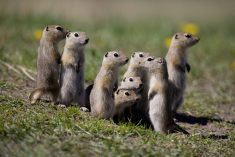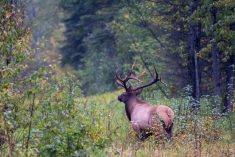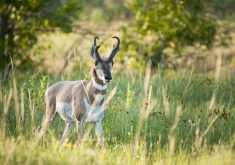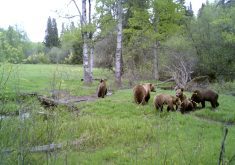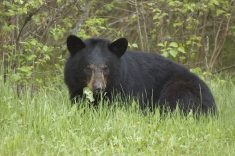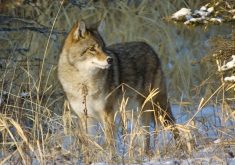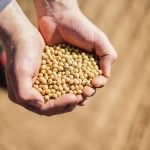The rapid spread of wild pig populations across Canada could have serious implications for agriculture.
Ryan Brook, associate professor at the University of Saskatchewan’s Indigenous Land Management Institute and Department of Animal and Poultry Science, warns that the expansion of this invasive species can lead to destructive consequences for livestock and crop production, as well as negative environmental impacts.
Brook, who runs the Canadian Wild Pig Research Project, has been working with his team for eight years, building from the ground up on a species of which little was known. Their latest research development, he reported, is likely their most important to date.
Read Also

Building demand together: The impact of Canada’s beef import levy
The beef import levy has become a central tool for ensuring balance in Canada’s beef industry
“We’ve developed a set of maps over the last three major periods from 1990 to present showing the spatial expansion of pigs across Canada,” said Brook. These maps are the first of their kind in Canada, with the strongest information yet. “Most alarming is how rapidly they’re spreading. In the last 10 years, on average they spread about 80,000 kilometres per year across all of Canada.”
Their early research explored the origin of wild pigs in Canada, which came from domestic herds. Domestic wild boars from Europe and Asia were imported to Canada in the late 1980s and early 1990s, primarily for meat production. Operations were set up in each province, with the largest number in Saskatchewan, but the market for wild boar meat didn’t grow as hoped. The animals also proved difficult to raise, with many instances of wild boars escaping from farms. More worrisome is the fact that some producers essentially gave up and cut their fences, letting hundreds of animals go.
Once these animals were loose in the wild, they began to thrive. “These animals are highly adapted to the cold,” said Brook. During this winter’s deep freeze, they just buried themselves under the snow, he added.

Wild pigs are now found across Canada, with the majority of sightings in the Prairie provinces. This is because many wild boar operations were established in the Prairies, and the habitat supports them well.
Populations have expanded rapidly due to their very high reproductive rate. “Wild pigs are having multiple litters per year, and the litter size on average in the Canadian Prairies is six,” said Brook.
Wild pigs also reach sexual maturity at a relatively young age, around four to six months. “Those numbers are just incredible in terms of how fast you take… one bred female and have more than 100 animals.”
The spread of wild pigs can be a major problem for livestock production and the environment due to their destructive nature, Brook said. Their large size and razor-sharp tusks make them dangerous to encounter; the largest wild pig that Brook and his team have handled to date was 638 pounds. As well, wild pigs will eat about anything, from canola to white tail deer, which they hunt. They’re also known to have an impact on wetlands by destroying waterfowl nests, tearing up plants and negatively affecting water quality.
Another issue is reports of wild pigs harassing livestock. “They’ll come in and scare animals off feed and off of water to the point that some producers here in Saskatchewan have told me they’ve had to move their feeding areas and watering areas because their cattle won’t go back to those areas due to harassment. The pigs are extremely aggressive,” he said.
While there are no known reports in Saskatchewan of wild pigs killing livestock, in the U.S. they are known to kill lambs and calves.
They also pose threats to crop production and pasture health, significantly damaging both. “Not only do they eat the crop, of course, but they lay in it and flatten it, and they rip up the ground to get at roots of different plants, so they’ll tear up pastures,” said Brook. “One night visit from 14 pigs and we’ll see large areas that just look like a rototiller went through.”
Aggressive action needed to decrease numbers
Brook has stated that Canada needs to address this issue, as populations will soon become “practically impossible to control.” While eradicating any invasive species is challenging, Brook explained that wild pigs are especially difficult to deal with because of how intelligent and mobile they are.
“It’s the most prolific invasive large mammal on earth,” he said. “Every year that the population increases in number and expands into new areas, it becomes that much more difficult. So I don’t think I will ever say that eradication is impossible for wild pigs. It really becomes how expensive it is.”

He referenced Texas, with its estimated population of three to four million wild pigs, as an example of how difficult eradication is in practice. “They kill hundreds of thousands of animals in a year, and that does not reduce the population.”
While his team is currently working to determine the total population of wild pigs in Canada, the species’ exponential growth paired with the difficulty in eradication creates the possibility for further challenges. “This idea of having more wild pigs than people in Saskatchewan is not an unreasonable thing to say.”
Eradicating wild pigs requires several aggressive methods working in conjunction. “There’s no silver bullet,” he said. “We have to have a whole bunch of tools in the toolbox, and all those tools have to be working together as part of a real science-based strategy.”
While strategies such as sport hunting only manage the populations, there has been success in putting GPS collars on one pig and follow it to a larger group, allowing hunters to remove all the pigs in the group.
Removing an entire group is the best way to reduce numbers, Brook said. Their experience, along with U.S. findings, show that only killing some of a group is ineffective, as the remaining animals will quickly reproduce and build their numbers back up.
“You go out and find a group of 10 and you kill six, it has no impact on the population,” he said. “You can continue to do that in Saskatchewan for the next 100 years and the population, I’m sure, will just keep growing.”
There are dedicated groups of hunters working to reduce wild pig numbers. One such group is located around Saskatchewan’s Moose Mountain Provincial Park.
“The local group are primarily cattle producers at Moose Mountain, who have worked with us for years and have been a huge supporter in getting our program going,” said Brook.
While this group has been highly successful in hunting wild pigs in the area, he is concerned that the spread of the animals will make their efforts all for naught. “They’ve done a great job in removing pigs in and around that park, but there’s enough pigs on the broader landscape that just keep coming in.”
Provincial and federal strategies are needed to deal with this invasive species, Brook stated. “We have no plan in Saskatchewan right now, and I think that’s to my mind the biggest gap.”
He would like to see partners such as related provincial departments and agriculture organizations collaborate to create a plan.
In the next stages of their research, Brook and his team plan to focus on genetics in order to better understand the source and movement of wild pigs, as well as the level of hybridization.
“Most of the pigs that you would see out in the wild in Saskatchewan today are some type of hybrid with domestic pigs, we think,” he said. He added they need to finish their genetic studies to confirm this hunch. They have genotyped numerous samples and are looking for funding to complete this work.
In addition to continuing their monitoring efforts through trail camera networks, they’re also working on the next layer on their map and tracking the movement of wild pigs. By using trail cameras to help estimate population density, they should soon be able to estimate the total number of wild pigs in Canada.
Brook is especially concerned about the lack of information available on diseases wild pigs may carry, citing current global disease concerns such as porcine epidemic diarrhea and African swine fever.
“There is no disease testing program in Canada for wild pigs, and to my knowledge there has been only a handful of animals that have been tested in Saskatchewan from a few spots,” he said. “We have no real idea of what the disease status is of wild pigs, so not only is it a potential serious impact on livestock producers but a real concern for spreading disease to wildlife, potentially to pets and humans as well.”
Brook would like to see disease testing move forward in the next few years. “We can collect samples, but it’s the Canadian Food Inspection Agency that needs to agree to do any testing.”
Other areas to explore include how livestock fit in to this issue. “There’s a massive need also to look at interactions between wild pigs and livestock,” he said, noting that due to the nature of domestic hog production, cattle are more likely to encounter wild pigs than their domestic counterparts. “So what does that mean for cattle in terms of everything from pasture to disease transmission to being pushed off feed in winter and pushed off those water sources in summer in other places?”
Obtaining funding for this research has been a challenge at times. They’ve received support from the University of Saskatchewan, Saskatchewan Pork and the Saskatchewan Wildlife Development Fund over the years. Funding from the U.S. Department of Agriculture has helped them to increase the size of their program.
Brook encourages producers to report wild pig sightings to the Canadian Wild Pig Research Project’s Facebook page. All information is confidential, and any sightings or photos go into their national database. They also ask hunters to submit ears from hunted pigs for their genetic database.




